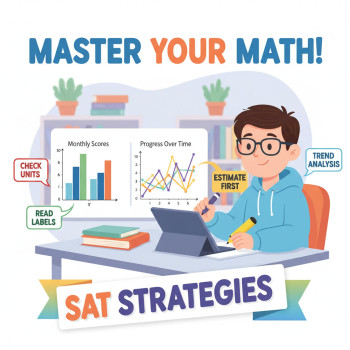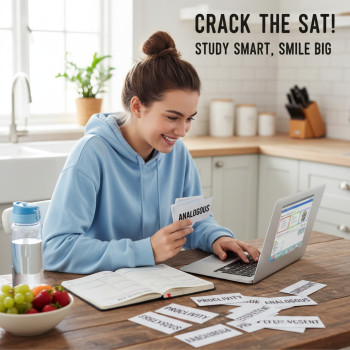Why this choice matters: the Digital SAT era and your family’s decision
If you’ve been navigating the college-admissions conversation the past few years, you probably know the SAT has changed — it’s gone digital, test delivery and timing are different, and the way students prepare has followed suit. For parents and students, the decision you’re facing now is less about whether to prep and more about how: do you sign up for a local test-prep center with in-person classes, or do you hire an online tutor (or a hybrid of both)? Both paths can work brilliantly — the key is matching the method to your student’s learning style, schedule, budget, and college goals.

How the Digital SAT changes the preparation landscape
The Digital SAT isn’t just the old test on a screen. Shorter passages, more focused questions, built-in calculators on the math portion, and an adaptive delivery model change what effective prep looks like. Students now encounter more numerous, shorter reading passages — which rewards quick passage-skimming strategies and precise time management. Math problems often appear more context-driven and concise. Also, because the test timing feels different on a device, students need practice managing digital fatigue and navigating the official test app’s interface.
All that means prep should include: deliberate practice with digital practice tests, strategies for short-text reading, device-based time management, and focused math review. Those are teachable in either a test-prep center or through online tutors — but each setting offers distinct advantages.
Local test-prep centers: what they bring to the table
Local centers—community colleges, specialty prep academies, or independent tutors working from a shared space—offer a structured environment many families find helpful. Here’s a breakdown of what you can expect:
- Structured schedule: Regular class times create a predictable routine, which helps students who thrive on consistency.
- Group learning dynamics: Peers can motivate one another, create healthy competition, and provide immediate group discussion for tricky problems.
- Face-to-face instruction: For students who prefer hands-on guidance or for whom in-person connection fuels focus, this is a major plus.
- Access to proprietary materials and timed practice sessions: Many centers run simulated digital test days to build stamina and reduce test-day anxiety.
- Clear deadlines and milestones: Cohort-based learning often comes with practice tests at set intervals, which makes progress easy to track.
When a local center is often the smarter choice
- Your student benefits from an in-person routine and social learning environment.
- You prefer an all-in-one package (curriculum, practice tests, and progress reports) with minimal coordination on your end.
- Access to local centers makes commute and scheduling practical.
- Test anxiety is reduced by supervised practice tests that simulate the in-person test-day experience.
Potential downsides to consider
- Class sizes may limit individual attention—struggling students can get lost in a larger group.
- Fixed schedules can clash with extracurriculars, schoolwork, or family life.
- Higher overhead for in-person services can mean higher costs for weekly classes.
Online tutors: flexibility, personalization, and modern tools
Online tutoring covers a wide range: from independent tutors meeting on Zoom to platforms that pair students with vetted educators and use data-driven dashboards. The online world is especially well-suited to the Digital SAT age—practice on devices is natural, and many online tutors integrate screen-sharing, digital practice exams, and interactive tools seamlessly.
- Personalized pacing: Lessons are one-on-one, so tutors can adapt content and pace to the student’s exact needs.
- Flexible scheduling: Sessions can be arranged evenings, weekends, or even compressed into travel days—great for busy families.
- Wide tutor selection: You can choose someone with a perfect fit for your student’s personality, subject needs (e.g., high-level math), or preferred teaching style.
- Often cost-effective: Because online operations have lower overhead, you may find better hourly rates and packages.
- Integration with digital practice: Tutors can use the same Bluebook-style practice exams and device-based strategies to replicate the testing experience.
When online tutoring is often the smarter choice
- Your child needs targeted, gap-focused instruction rather than general review.
- Scheduling conflicts make a strict class schedule impractical.
- You want the flexibility to change tutors as needs evolve or to get specialized help (e.g., grid-in math, evidence-based reading strategies).
Potential downsides to consider
- Online distraction is real—some students struggle to stay focused without a supervised setting.
- Quality varies; the right tutor search takes time and trial lessons.
- Less peer interaction can make motivation uneven for some teens.
Key comparison: side-by-side at a glance
| Feature | Local Test Prep Center | Online Tutor |
|---|---|---|
| Instruction type | Group classes, occasional 1-on-1 options | 1-on-1 personalization; small groups possible |
| Schedule | Fixed weekly times | Very flexible; evenings/weekends |
| Cost | Often higher for full programs | Varies; can be more cost-effective hourly |
| Test simulation | In-person proctored practice tests | Digital timed practice that mirrors Bluebook™ |
| Accountability | Built-in via class structure | Depends on tutor and family follow-through |
| Best for | Students who thrive with routine and in-person interaction | Students who need tailored skill remediation or tight scheduling |
How to choose: practical questions parents should ask
Rather than seizing the first shiny option, take 6–8 weeks to evaluate your child’s needs and answer the following — ideally with your student in the conversation.
- What are the target colleges’ testing expectations? If your student is aiming at selective schools that look closely at test scores, a more intensive plan may make sense.
- How does your teen learn best? Do they need peer energy and a teacher at the front of the room, or do they focus best in a quiet, personalized online session?
- What level of personalization is needed? If your student has specific weaknesses (e.g., data analysis, grammar rules), a tutor will likely move the needle faster.
- What’s the schedule reality? Long commutes plus late practices plus classes can make attendance at a weekly center class impractical.
- Budget and ROI: Consider cost per score point improvement — not glamorous, but useful. Talk to providers about average gains and how they measure progress.
- How will progress be measured? Look for providers (center or tutor) who use regular full-length digital practice tests and clearly report progress.
Designing a hybrid plan that often works best
For many families the best solution isn’t one or the other — it’s both. For example:
- Start with a local boot camp for a month to build fundamentals and test-day familiarity, followed by weekly online tutoring for targeted remediation.
- Use in-person full-length practice tests at a center to build stamina, paired with online weekly sessions for tactics and targeted review.
- Consider short, intensive in-person workshops around scheduled practice tests (e.g., a weekend before a full-length exam) combined with regular online check-ins.
This hybrid approach gets the accountability and simulation benefits of in-person work while preserving the precision and flexibility of one-on-one online tutoring.
What to expect in terms of timeline and score improvement
While every student’s growth curve is different, here’s a reasonable framework to set expectations:
- 4–8 weeks focused prep (3–6 hours/week): typically yields modest, steady improvements — clarity in weak areas and small score gains.
- 8–12 weeks (5–8 hours/week): often produces measurable improvement of several score points as practice tests and targeted lessons compound.
- 12+ weeks with consistent practice and quality instruction: substantial gains for students with clear motivation and consistent study habits.
Remember: the Digital SAT’s adaptive feel rewards targeted improvement; strengthening specific content areas (e.g., algebra foundations or reading-for-evidence strategies) often produces quicker score lifts than unfocused studying.
Red flags to avoid when selecting centers or tutors
- Promises of guaranteed perfect scores or unrealistic point jumps — legitimate improvement takes time.
- Vague progress tracking — insist on clear baseline and periodic full-length practice tests that mimic the digital format.
- No opportunity to try before committing — look for trial lessons or short-term packages.
- Over-reliance on outdated materials — ensure practice mimics the digital test (short passages, device interface, Bluebook-style timing).
Questions to ask before you sign up
- How do you simulate the Digital SAT experience in practice tests? (Look for device-based timed practice and official-style adaptive simulations.)
- How is progress measured and reported to families?
- What is the tutor’s or instructor’s experience with digital testing strategies and the Bluebook app?
- Is there flexibility to switch formats if the arrangement isn’t working?
- What are the typical results for students with a profile similar to my child’s?
How parents can support success regardless of the format
Whether you choose a local center, an online tutor, or both, your involvement makes a difference. Here are practical, research-backed ways to support your student:
- Foster consistent, scheduled study blocks rather than last-minute cramming.
- Encourage device-based practice so the student grows comfortable with the digital interface.
- Help set concrete, measurable mini-goals (e.g., “improve algebra section accuracy to 85% within 6 weeks”).
- Normalize practice tests as learning tools — review mistakes together without blame and create an action plan for each missed concept.
- Make wellness part of the plan: sleep, nutrition, and exercise influence cognitive performance more than most parents expect.
Real-world example: two family stories
Seeing how real families navigate the decision can help clarify what might fit your own. Below are two short, composite scenarios drawn from common patterns I’ve coached parents through.
Case A: The busy athlete — hybrid success
Leah plays varsity soccer and wanted to avoid missing practice. Her family chose a hybrid plan: a weekend in-person diagnostic and a proctored practice test at a local prep center, then weekly online 1-on-1 sessions that focused on her weakest areas. The local center’s simulated test helped her reduce test-day nerves; the online tutor targeted specific algebra topics that were dragging her score down. Over three months, Leah gained significant points and felt less stressed on test day.
Case B: The independent learner — online-only and efficient
Sam is an introvert who thrives in independent study. He and his parent vetted a series of online tutors, checked references, and chose a tutor who specialized in reading strategies for the digital format. Twice-monthly full-length digital practice tests tracked his progress. Sam made steady improvements while keeping his evening rhythm intact.
How Sparkl can fit into your plan
If you’re weighing options, consider solutions that blend human expertise with data-driven personalization. Sparkl offers 1-on-1 guidance, tailored study plans, and expert tutors who understand the Digital SAT — they pair focused human instruction with AI-driven insights to spot patterns in practice tests and prioritize the concepts that will move the score needle. Families often find Sparkl helpful when they want the flexibility of online tutoring plus the structure of a clear, personalized plan.
Used thoughtfully, a service like this can be an efficient way to centralize progress reports, access expert tutors, and get AI-assisted recommendations without the commute.
Budgeting and value: how to think about cost
Cost matters — and it should be balanced against expected return. Rather than focusing only on hourly rates, estimate the total program cost and divide by expected score improvement to approximate cost-per-point. This isn’t perfect, but it helps keep expectations realistic. Ask any provider for sample plans at different commitment levels (e.g., 8 weeks vs. 12 weeks) and what typical results look like for students like yours.
Practical checklist for final selection
- Confirm that digital practice tests are device-based and modeled on the official test interface.
- Ask for a short trial period or one-time diagnostic to evaluate teaching chemistry.
- Request a clear progress-reporting schedule and examples of past students’ improvement.
- Make sure the instructor or center discusses test-day logistics (timing, breaks, device rules) for the digital format.
- Build in a contingency plan: if progress stalls after an agreed period, you’ll pivot strategies (switch tutor, add practice tests, or consider in-person options).
Final thoughts: choose the plan that fits the student, not the family fears
There’s no universal ‘best’ route. The right choice depends on your student’s personality, schedule, and learning needs. Local test-prep centers deliver community, structure, and supervised practice — great for students who flourish with in-person energy. Online tutors deliver personalization, flexibility, and targeted skill development — excellent for students with specific gaps or busy lives. And often, a thoughtful hybrid approach takes the best from both worlds.
As you decide, keep the conversation open with your student, prioritize practice that mirrors the Digital SAT experience, and build a timeline that reduces anxiety rather than adding to it. With clear goals, consistent practice, and the right support—whether from a local center, an online tutor, or a personalized program like Sparkl—your student can enter test day confident and ready to perform their best.
Quick reference: action steps this week
- Schedule a diagnostic practice test (digital) to establish a baseline.
- Talk with your student about preferred learning style and availability.
- Request trial lessons from two options: one local center and one online tutor.
- Create a simple 8-week study calendar with practice-test checkpoints every 3–4 weeks.
- Plan one in-person or simulated proctored practice test in the final 2–3 weeks before the target test date.

Parting reassurance
Choosing between local prep centers and online tutors can feel like a big decision, but remember it’s not permanent. Most families revise their plans as they learn what works. Start with a clear baseline, pick a short commitment, and measure progress. That iterative approach — experiment, measure, adapt — is the most reliable path to the score and confidence your student needs for college applications.
Your support, practical planning, and steady encouragement will matter as much as the lessons themselves. Good luck — and may your student’s prep be purposeful, manageable, and even occasionally fun.














No Comments
Leave a comment Cancel